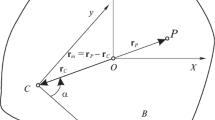Abstract
In a flat case, we consider the task of rotating a solid body by the given angle for the minimum possible time by using a mobile mass (interacting with this body) whose movements are restricted by the interior of the given circle. The corresponding two-point time-optimal control problem for a system with three phase variables (in the presence of a phase constraint) is investigated. The presence of the continuum of, first, curves that meet the necessary conditions of optimality and, second, the sought optimal trajectories are shown. In the case where the mobile mass begins and ends its movement on the edge of the circle, the optimal trajectories and the duration of the movement of this mass are obtained. The study is based on the analysis of a one-dimensional mechanical system whose movements correspond to the solutions of the equations of the three-dimensional problem for the optimal controls.







Similar content being viewed by others
REFERENCES
F. Schmoeckel and H. Worn, “Remotely controllable microrobots acting as nano positioners and intelligent tweezers in scanning electron microscopes (SEMs),” in Proceedings of the International Conference on Robotics and Automation (IEEE, New York, 2001), Vol. 4, pp. 3903–3913.
P. Vartholomeos and E. Papadopoulos, “Dynamics, design and simulation of a novel microrobotic platform employing vibration microactuators,” Trans. ASME, J. Dyn. Syst., Meas. Control 128, 122–133 (2006).
F. L. Chernousko, “Two-dimensional motions of a body containing internal moving masses,” Meccanica 51, 3203–3209 (2016).
F. L. Chernousko, “Optimal control of the movement of the two-mass system,” Dokl. Math. 97, 297 (2018).
M. V. Levskii, “Synthesis of the optimal control of the spacecraft orientation using combined criteria of quality,” J. Comput. Syst. Sci. Int. 58, 980 (2019).
A. M. Shmatkov, “Objects changing the spatial orientation of a solid body by using mobile mass,” J. Comput. Syst. Sci. Int. 59, 622 (2020).
A. M. Shmatkov, “Influence of the size of a controllable device on time-optimal rotation generated by a moving internal mass,” Dokl. Math. 99, 325 (2019).
A. M. Shmatkov, “Time-optimal rotation of a body by displacement of a mass point,” Dokl. Phys. 63, 337 (2018).
L. S. Pontryagin, V. G. Boltyanskii, R. V. Gamkrelidze, and E. F. Mishchenko, The Mathematical Theory of Optimal Processes (Nauka, Moscow, 1983; Wiley, New York, 1962).
F. L. Chernousko and A. M. Shmatkov, “Optimal control of rotation of a rigid body by a movable internal mass,” J. Comput. Syst. Sci. Int. 58, 335 (2019).
I. S. Gradshtein and I. M. Ryzhik, Tables of Integrals, Series and Products (GIFML, Moscow, 1963; Academic, New York, 1980).
P. K. Rashevskii, Course of Differential Geometry (GITTL, Moscow, Leningrad, 1950) [in Russian].
A. M. Shmatkov, “Periodic solutions of the problem on optimal control of the rigid body rotation with the help of inner mass,” Vestn. Mosk. Univ., Mat., Mekh., No. 3, 63–67 (2020).
A. P. Markeev, Theoretical Mechanics (CheRo, Moscow, 1999) [in Russian].
L. D. Landau and E. M. Lifshitz, Course of Theoretical Physics, Vol. 1: Mechanics (Nauka, Moscow, 1982; Pergamon, New York, 1988).
Funding
This work was supported by the Russian Science Foundation, grant no. 18-11-00307.
Author information
Authors and Affiliations
Corresponding author
Additional information
Translated by L. Kartvelishvili
Rights and permissions
About this article
Cite this article
Shmatkov, A.M. Control of a Moving Mass with the Initial and Final Position on the Boundary of the Area of Motion in Order to Achieve the Fastest Rotation of a Solid Body. J. Comput. Syst. Sci. Int. 60, 559–575 (2021). https://doi.org/10.1134/S106423072103014X
Received:
Revised:
Accepted:
Published:
Issue Date:
DOI: https://doi.org/10.1134/S106423072103014X




